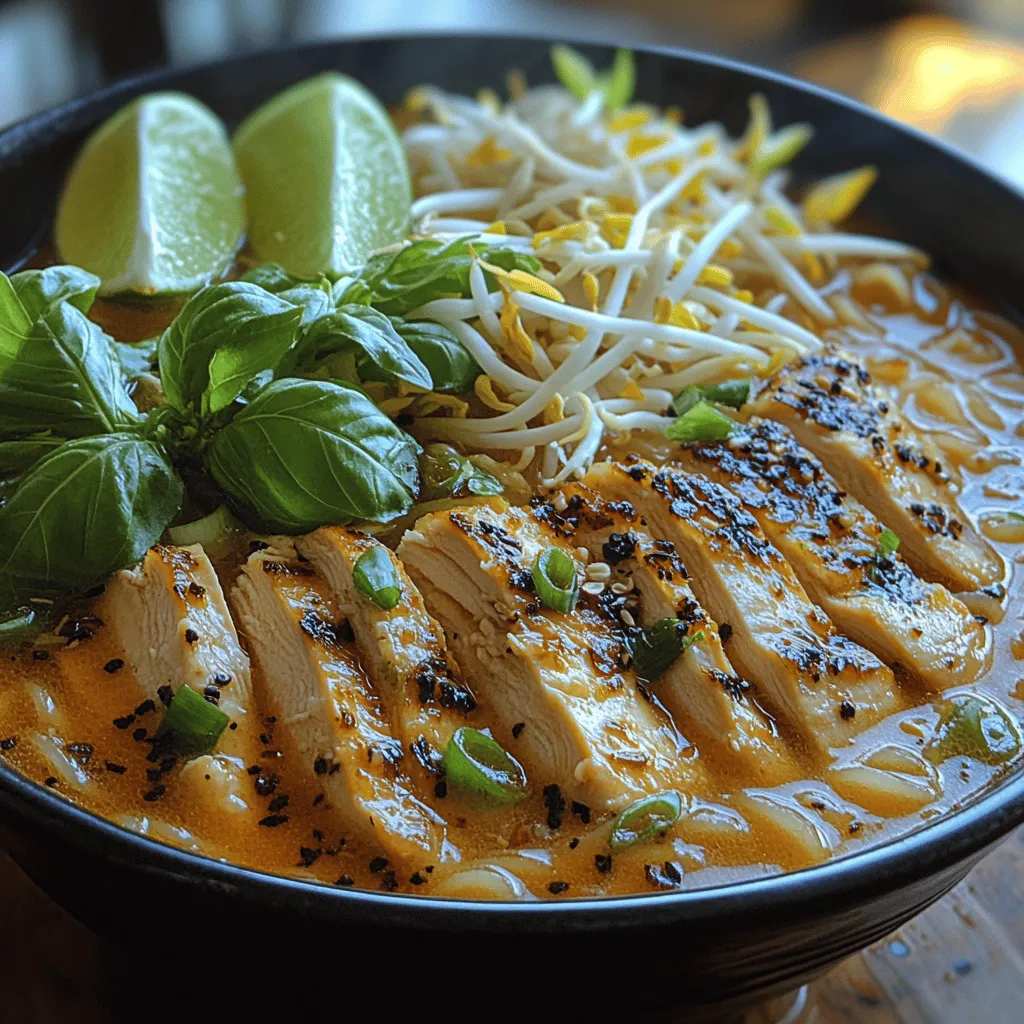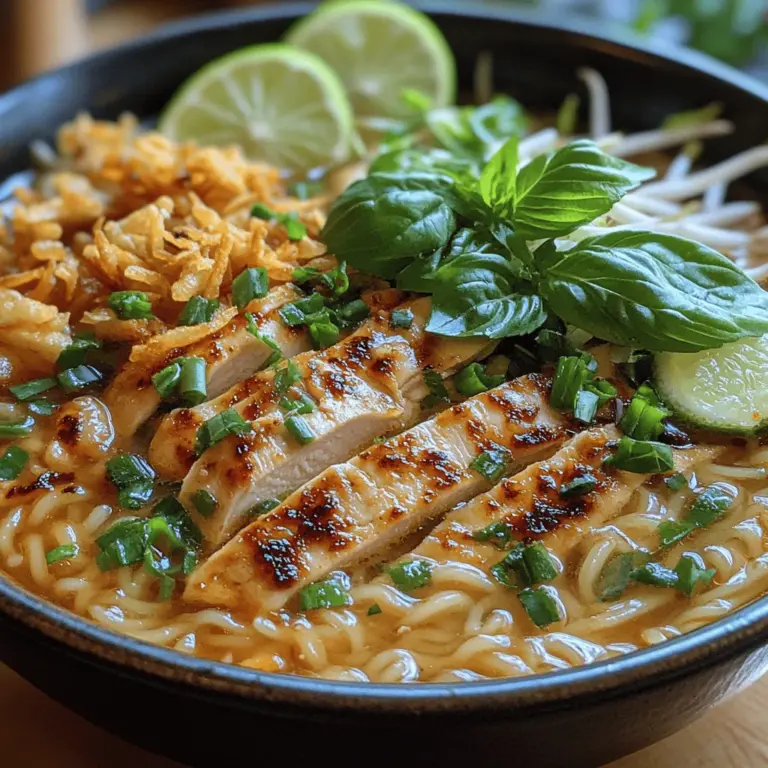Introduction
Pho, pronounced “fuh,” is more than just a meal; it’s a cultural experience deeply embedded in Vietnamese cuisine. Among its many variations, Fragrant Lemongrass Chicken Pho stands out for its aromatic flavors and comforting broth. This delightful dish marries tender chicken with the unique zest of lemongrass, creating a fragrant soup that warms the soul and tantalizes the taste buds. Whether you are a seasoned chef or a home cook looking to explore new culinary horizons, this recipe offers a chance to experience the robust flavors of Vietnam in your kitchen.
The magic of lemongrass chicken pho lies in its harmonious blend of fresh herbs, spices, and quality ingredients that come together to create a dish that is both satisfying and nourishing. The key ingredients—lemongrass, chicken, rice noodles, and a variety of fresh herbs—play a crucial role in defining the dish’s unique taste. Each component contributes to the complex flavor profile, making it a favorite for many and a staple in Vietnamese households.
Understanding the Dish
Historical Background and Origin
Pho has a rich history that can be traced back to the early 20th century in Vietnam. It is believed to have originated in northern Vietnam, possibly influenced by French colonialism and the introduction of new cooking techniques and ingredients. The word “pho” is thought to be derived from the French word “pot-au-feu,” which means “pot on the fire,” signifying the broth-based nature of the dish.
Over the years, pho has evolved and taken on many regional variations. While beef pho, or “pho bo,” is perhaps the most famous, chicken pho, or “pho ga,” has gained its own following due to its lighter and more aromatic broth. The use of lemongrass in chicken pho adds an additional layer of flavor, making it a beloved choice for those seeking a refreshing yet hearty meal.
Cultural Significance and Variations in Different Regions
In Vietnam, pho is more than just food; it is a symbol of national pride and cultural identity. It is commonly enjoyed for breakfast but can be found at any time of day. Street vendors and local eateries serve pho with a plethora of toppings, allowing each diner to customize their bowl to their liking.
Regional variations abound, with northern pho typically featuring a clearer broth and fewer toppings, while southern pho is often accompanied by a wider array of fresh herbs and condiments. In central Vietnam, pho can be spicy and flavorful, showcasing the region’s love for bold tastes. Each variation tells a story, reflecting the local ingredients, culinary traditions, and the preferences of the people.
Nutritional Benefits of the Main Ingredients
Lemongrass chicken pho not only delights the palate but also offers numerous nutritional benefits. The main ingredients contribute essential nutrients and health advantages:
– Lemongrass: This aromatic herb is known for its anti-inflammatory properties and digestion-enhancing qualities. It is rich in vitamins A and C, as well as folate, which supports overall health.
– Chicken: A lean protein source, chicken provides essential amino acids necessary for muscle repair and growth. It is also low in fat when skinless, making it a healthy choice for those watching their cholesterol levels.
– Rice Noodles: Gluten-free and easily digestible, rice noodles serve as a great carbohydrate source, providing energy without the heaviness often associated with wheat-based pasta.
– Fresh Herbs: Herbs such as cilantro, basil, and mint are not only flavorful but also packed with antioxidants, vitamins, and minerals that support immune health and add a burst of freshness to the dish.
– Vegetables: Often garnished with bean sprouts, green onions, and lime, these vegetables add additional nutrients and fiber to the meal, making it a well-rounded option for any diet.
Ingredients Breakdown
To create a delicious bowl of Fragrant Lemongrass Chicken Pho, you’ll need a variety of fresh ingredients that work together to build the flavor profile of the dish. Here’s a detailed breakdown of what you’ll need:
Detailed List of Ingredients
1. For the Broth:
– 1 whole chicken or bone-in chicken parts (preferably thighs or drumsticks)
– 2 stalks of lemongrass (bruised and cut into pieces)
– 1 onion (halved)
– 4-5 slices of ginger (peeled)
– 4-5 whole star anise
– 3-4 cloves
– 1 cinnamon stick
– Salt to taste
– Water (approximately 2-3 liters)
2. For the Noodles and Toppings:
– 200g rice noodles (banh pho)
– Fresh herbs: cilantro, Thai basil, mint
– Bean sprouts
– Jalapeño or red chili (sliced, optional)
– Lime wedges (for serving)
– Green onions (sliced)
Fresh Produce: Vegetables and Herbs
The freshness of the herbs and vegetables is crucial in bringing out the flavors of the pho. Opt for high-quality, organic produce whenever possible to maximize taste and nutritional value. Fresh herbs like cilantro, Thai basil, and mint not only enhance the flavor of the dish but also provide essential nutrients and antioxidants.
Proteins: Types and Sources
For the protein component, chicken is the star of this recipe. You can choose a whole chicken for a richer broth or use specific cuts such as thighs or breasts, depending on your preference. If you’re looking for alternatives, consider using tofu for a vegetarian version or even seafood, such as shrimp, for a different twist on this classic dish.
Grains or Bases: Options and Substitutions
Rice noodles are the traditional choice for pho, providing a delicate texture that complements the broth. However, if you’re looking for a gluten-free option, rice noodles are naturally gluten-free. If you want to experiment, you could substitute with other types of noodles, but keep in mind that the flavor profile may change.
Importance of Ingredient Quality
The quality of your ingredients can make or break your pho. Fresh, high-quality products will yield a more flavorful broth and a more satisfying dish overall. When possible, visit local markets or specialty stores to find the freshest produce and meats.
Tips for Sourcing Ingredients Sustainably
When sourcing ingredients for your pho, consider looking for local suppliers, farmers’ markets, or organic grocery stores. Not only do these options often provide fresher produce, but they also support sustainable farming practices. Additionally, if you can grow your own herbs, you’ll ensure the freshest flavors while minimizing your environmental footprint.
Preparation Steps
Before diving into the cooking process, proper preparation is key to creating a delicious bowl of pho. Here are the steps to get your ingredients ready:
Prepping the Ingredients
Start by gathering all your ingredients and ensuring they are fresh. Rinse the chicken under cold water and pat it dry with paper towels. This will help remove any impurities and excess moisture.
Washing and Cutting Techniques
– Lemongrass: Trim the ends and remove the tough outer layers. Use the softer inner stalks, and lightly bruise them with the back of a knife to release their essential oils.
– Onion and Ginger: Halve the onion and peel the ginger before slicing it into pieces. This allows the flavors to infuse the broth more effectively.
– Herbs: Rinse the fresh herbs thoroughly under cold water and pat them dry. Keep them whole until you’re ready to serve to maintain their freshness.
Importance of Mise en Place
Mise en place, a French term meaning “everything in its place,” is crucial in cooking, especially for complex dishes. By prepping your ingredients ahead of time, you’ll streamline the cooking process and ensure that everything flows smoothly, allowing you to focus on the flavors and techniques rather than scrambling for ingredients.
Cooking Methods Explained
Pho typically involves several cooking methods:
– Sautéing: Start by sautéing the onion and ginger in a dry pot until fragrant. This step adds depth to the broth.
– Boiling: The broth is created by boiling the chicken along with the aromatics and spices. This method helps to extract flavors from the chicken and the herbs.
– Simmering: After boiling, the broth should be simmered for at least an hour to allow the flavors to meld together, creating a rich and aromatic base.
Recommended Cookware and Tools
To make your cooking experience easier, use the following tools:
– A large stockpot: This is essential for making your broth and accommodating all the ingredients.
– A fine mesh strainer: To strain the broth once it’s finished cooking, ensuring a clear soup without any bits of herbs or spices.
– A sharp knife and cutting board: For chopping and preparing your ingredients efficiently.
– A ladle: For serving the broth into bowls.
With your ingredients prepped, and all tools ready, you’re set to embark on the journey of making Fragrant Lemongrass Chicken Pho. In the next section, we will dive into the step-by-step cooking instructions, guiding you through the process of creating this warm and inviting dish.
 Fragrant Lemongrass Chicken Pho stands out for its aromatic flavors and comforting broth. This delightful dish marries tender chicken with the unique zest of lemongrass, creating a fragrant soup that warms the soul and tantalizes the taste buds. Whether you are a seasoned chef or a home cook looking to explore new culinary horizons, this recipe offers a chance to experience the robust flavors of Vietnam in your kitchen.” />
Fragrant Lemongrass Chicken Pho stands out for its aromatic flavors and comforting broth. This delightful dish marries tender chicken with the unique zest of lemongrass, creating a fragrant soup that warms the soul and tantalizes the taste buds. Whether you are a seasoned chef or a home cook looking to explore new culinary horizons, this recipe offers a chance to experience the robust flavors of Vietnam in your kitchen.” />
Clear, Detailed Instructions for Each Stage of the Recipe
Preparation
1. Gather Your Ingredients: Start by assembling all your ingredients. For the Fragrant Lemongrass Chicken Pho, you will need chicken thighs, fresh lemongrass, ginger, garlic, onions, star anise, cinnamon sticks, and fish sauce. Ensure you have fresh herbs like cilantro and basil, as well as lime wedges for serving.
2. Prepare the Broth: Begin by preparing your broth. In a large pot, heat a tablespoon of vegetable oil over medium heat. Add 1 large onion (quartered), 2 stalks of lemongrass (trimmed, smashed, and cut into 3-inch pieces), a thumb-sized piece of ginger (sliced), and 3 cloves of garlic (smashed). Saute these aromatics for about 5 minutes until they are fragrant and slightly caramelized.
3. Add Chicken and Spices: Next, add 4 cups of water to the pot, followed by 1 pound of boneless, skinless chicken thighs. Toss in 1 star anise, 1 cinnamon stick, and 2 tablespoons of fish sauce. Bring the mixture to a gentle simmer. Skim off any foam that rises to the surface to keep your broth clear.
4. Simmer the Broth: Allow the broth to simmer for about 30-40 minutes. This slow cooking process helps to infuse the flavors of the aromatics and spices into the chicken, resulting in a rich and fragrant broth.
5. Cook the Noodles: While the broth simmers, prepare the rice noodles. In a separate pot, bring water to a rolling boil. Add 8 ounces of rice noodles and cook according to package instructions, usually for about 4-5 minutes, or until they are tender but still firm. Drain the noodles and rinse them under cold water to prevent sticking.
6. Shred the Chicken: Once the chicken is cooked through, remove it from the broth and let it cool slightly. Using two forks, shred the chicken into bite-sized pieces. Return the shredded chicken to the broth and let it warm through.
7. Final Touches: Taste the broth and adjust seasoning as needed, adding more fish sauce for saltiness or a bit of lime juice for acidity.
Cooking Time and Temperature Settings
– Preparation Time: Approximately 15 minutes
– Cooking Time: 40-50 minutes for broth, plus 5 minutes for noodle cooking
– Temperature Settings: Medium heat for sautéing, followed by a low simmer for the broth.
Tips for Achieving the Perfect Flavor and Texture
– Use fresh lemongrass, as it provides a bright, citrusy flavor that dried versions cannot replicate.
– Don’t rush the simmering process; allowing the broth to gently simmer helps to extract maximum flavor from the ingredients.
– If you prefer a deeper broth, consider roasting the chicken thighs before adding them to the pot.
– Always taste the broth before serving. Every ingredient can vary in strength, so adjustments might be needed.
Serving Suggestions
Presentation Ideas for the Finished Dish
– Serve the Pho in large, shallow bowls to allow for ample noodle and broth visibility.
– Garnish each bowl with freshly chopped cilantro, basil, and thinly sliced green onions for a pop of color.
– Add lime wedges on the side for guests to squeeze over their Pho, enhancing the dish’s brightness.
Pairing Recommendations
– Pair your Pho with a refreshing Vietnamese iced coffee or a light lager beer to complement the spices in the broth.
– For sides, consider serving spring rolls or a light Vietnamese salad to balance the richness of the soup.
Ideal Occasions for Serving This Dish
– Fragrant Lemongrass Chicken Pho is perfect for cozy family dinners, casual gatherings with friends, or as a flavorful dish to impress guests during special occasions.
– It also works wonderfully during colder months as a comforting, warming meal.
Flavor Variations and Customizations
Suggestions for Altering the Recipe to Suit Different Tastes
– For a spicier version, add slices of fresh jalapeño or a dash of chili oil to the broth.
– For a richer flavor, you can add a few dashes of soy sauce or hoisin sauce for a sweet umami kick.
Vegetarian, Vegan, and Gluten-Free Adaptations
– Vegetarian/Vegan: Substitute chicken with tofu or mushrooms. Use vegetable broth instead of chicken broth and replace fish sauce with soy sauce or a vegan fish sauce alternative.
– Gluten-Free: Ensure that the rice noodles are certified gluten-free and replace any soy sauce with tamari.
Spices and Herbs to Enhance Flavor Profiles
– Experiment with adding a few cardamom pods or cloves during the simmering process for a unique flavor twist.
– Try incorporating fresh herbs like mint or Thai basil to provide additional layers of flavor.
Storage and Reheating Tips
Best Practices for Storing Leftovers
– Allow the Pho to cool completely before transferring it into airtight containers. Store the broth and noodles separately to prevent the noodles from becoming mushy.
– The Pho broth can be stored in the refrigerator for up to 3 days or frozen for up to 3 months.
How to Properly Freeze the Dish
– To freeze, carefully ladle the broth into freezer-safe containers, leaving space at the top for expansion.
– Store cooked noodles in a separate container, ensuring they are also cooled before freezing.
Recommended Reheating Methods to Maintain Quality
– Reheat the broth gently on the stove over low heat, adding fresh herbs and lime juice to brighten the flavors before serving.
– For noodles, quickly soak them in hot water or briefly heat them in a pan with a splash of broth to restore their texture.
Common Mistakes to Avoid
Common Pitfalls When Preparing the Dish
– Avoid boiling the broth too vigorously, as this can lead to a cloudy broth and tough chicken.
– Don’t skip the skimming step; removing impurities will enhance the broth’s clarity and flavor.
How to Troubleshoot Issues That May Arise
– If the broth tastes bland, consider adding more fish sauce or a touch of sugar to balance out the flavors.
– Should the broth become too salty, adding a bit of water can help dilute it, but be cautious not to lose the flavor.
Tips for Ensuring Consistent Results
– Follow the measurements closely, especially with spices and seasonings, as they can significantly affect the overall taste.
– Taste as you go; this way, you can make adjustments to suit your personal preference.
Conclusion
Fragrant Lemongrass Chicken Pho is a delightful dish that embodies the essence of Vietnamese cuisine with its aromatic broth, tender chicken, and fresh herbs. This versatile recipe can be easily adapted to suit various dietary needs and flavor preferences, making it a perfect choice for any occasion—from family dinners to festive gatherings.
Cooking this dish not only allows you to explore the rich tapestry of flavors that define Pho, but it also offers an opportunity to share a warm, comforting meal with loved ones. So gather your ingredients, follow these detailed instructions, and savor the joy of a homemade bowl of fragrant Lemongrass Chicken Pho. Enjoy the process of cooking and the satisfaction of sharing a meal that brings everyone together.

